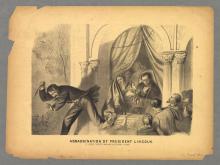I came to the American Antiquarian Society in the Fall of 1995 to research and write a play called Sockdology about the actors who were in Our American Cousin the night Abraham Lincoln was assassinated at Ford’s Theater. I didn’t know quite what to expect when I arrived, what the AAS routines and rhythms would be. Most of the other fellows were engaged in research of a more traditional kind, or at least for more traditional kinds of projects: books, studies, etc.
As an artist fellow, there was something exotic about my presence, although I find nothing exotic about a playwright writing for the theater. Within days the rhythm of the place had asserted itself: coming in at 9:00, putting one’s things in the locker, the soft pencil and paper, the requests made on cards. There was information to be had, but some of the richest discoveries were in the realm of the atmospheric: programs, posters, the kind of typeface and coloring used in playbills and flyers; the ways in which actors, composers, and yes, playwrights, presented themselves in the 19th century.
Writers look for dates, facts, quotes, all vitally important, especially when working on a piece of dramatic invention based on fact. But there is as much or more inspiration in a handbill advertising a final performance or an advertisement using the image of an actor to sell a product. All this: the style of the time, its flair, its excesses and demurrals, make up the soil and seed from which a book, a play, a poem, a film script, may grow. I loved my month in Worcester at the American Antiquarian Society. Would that I could do it again.

Assassination of President Lincoln, lithograph, not before 1865.